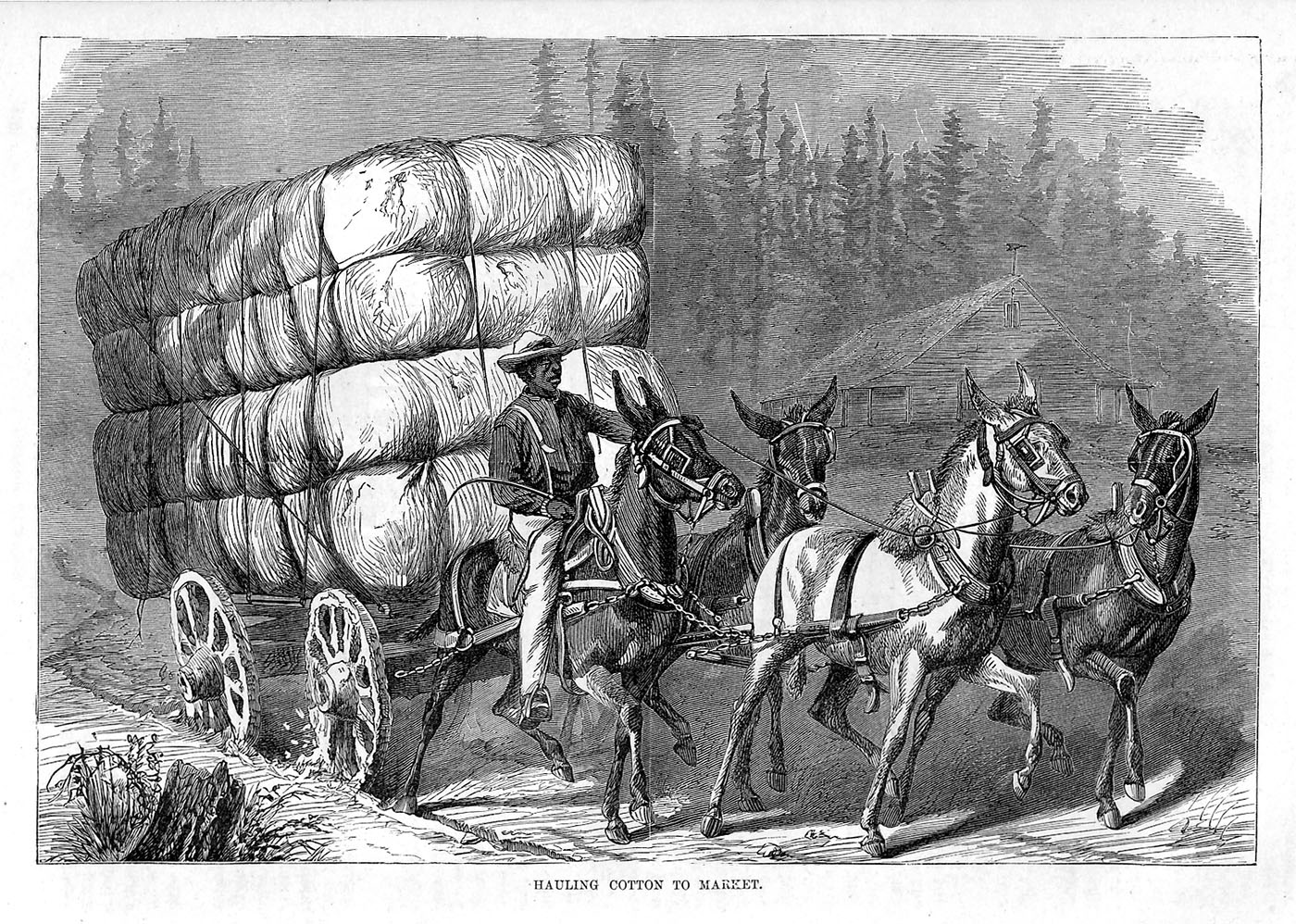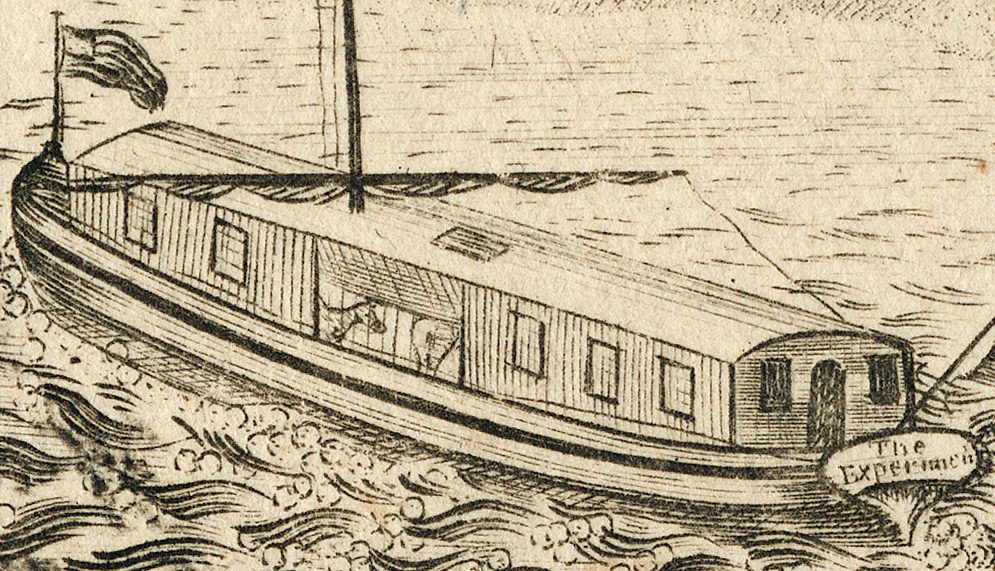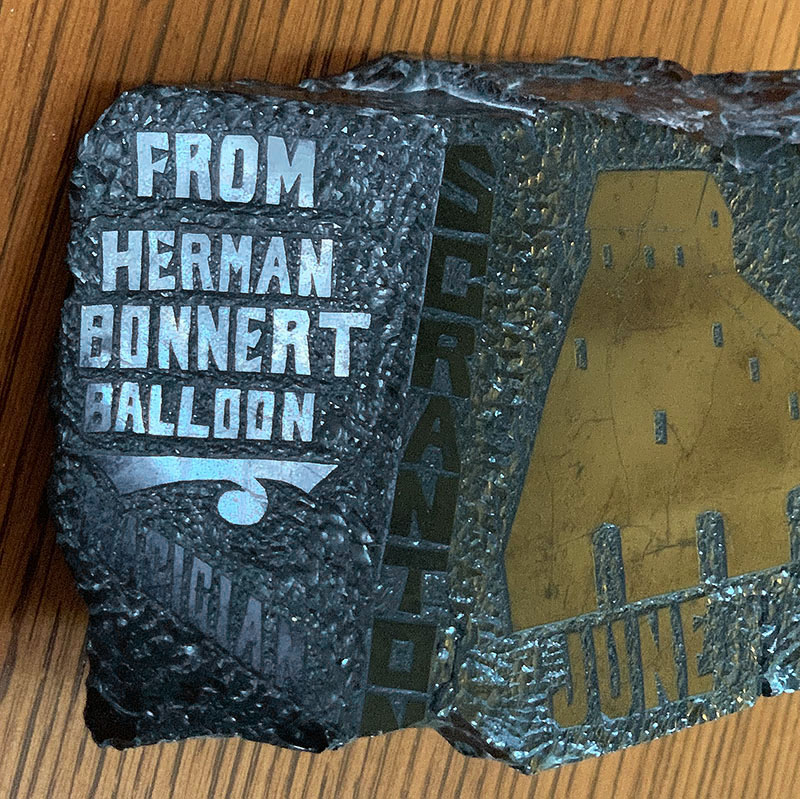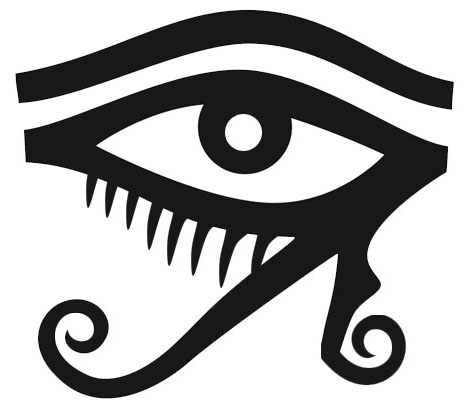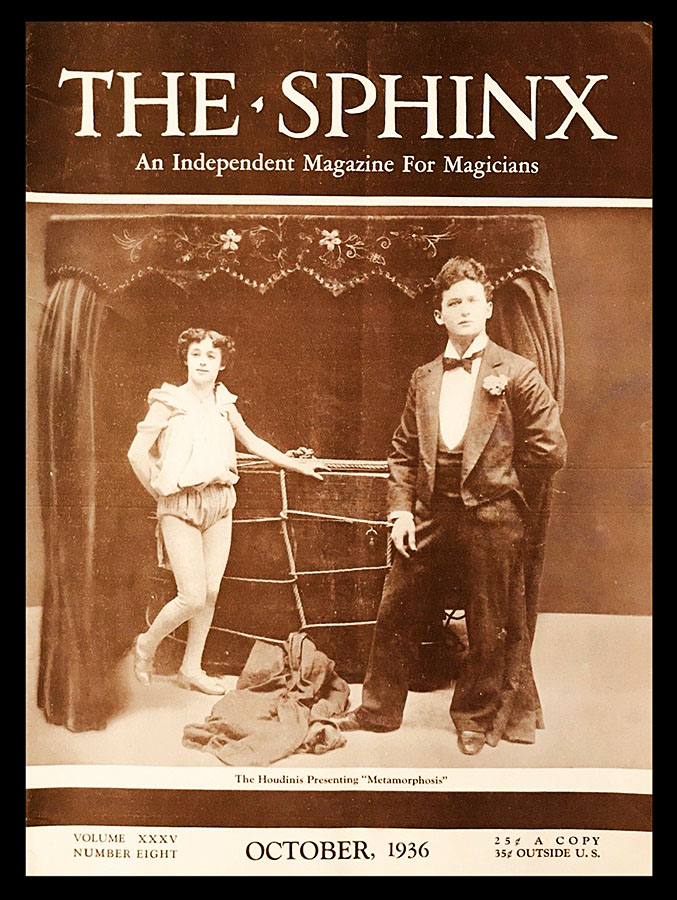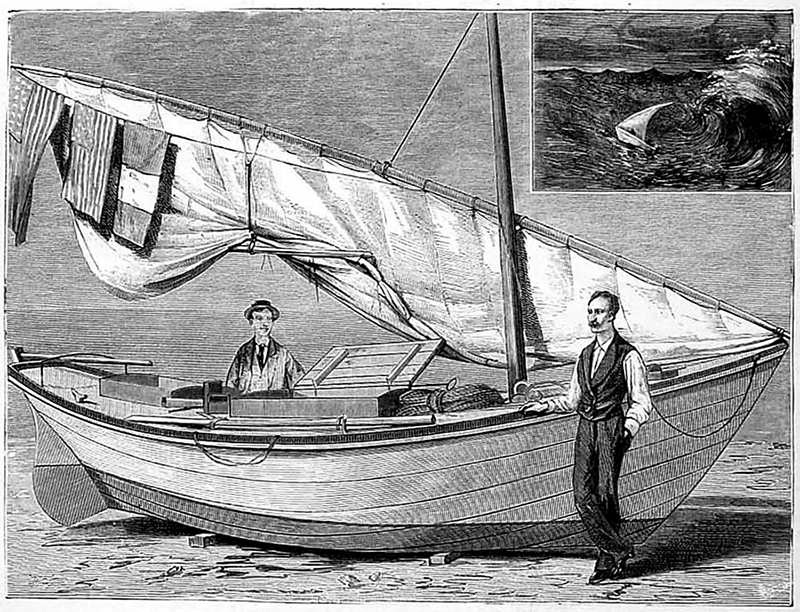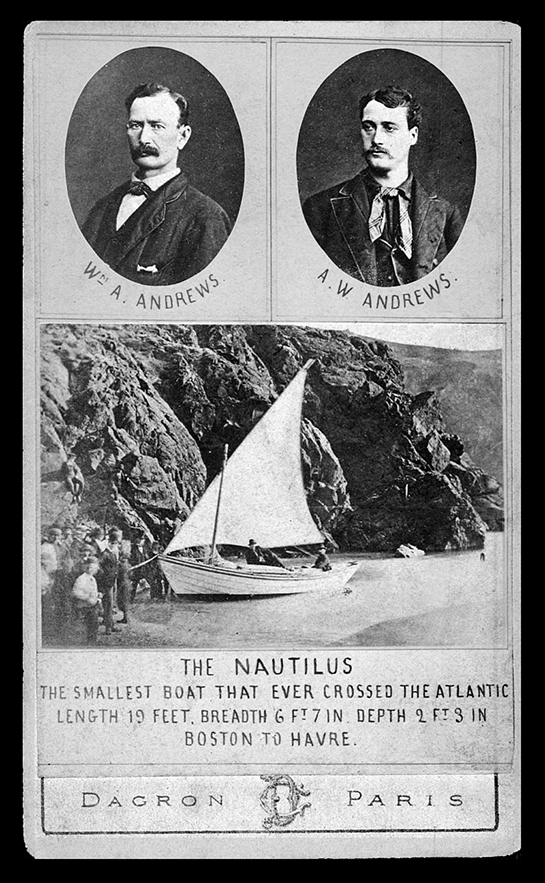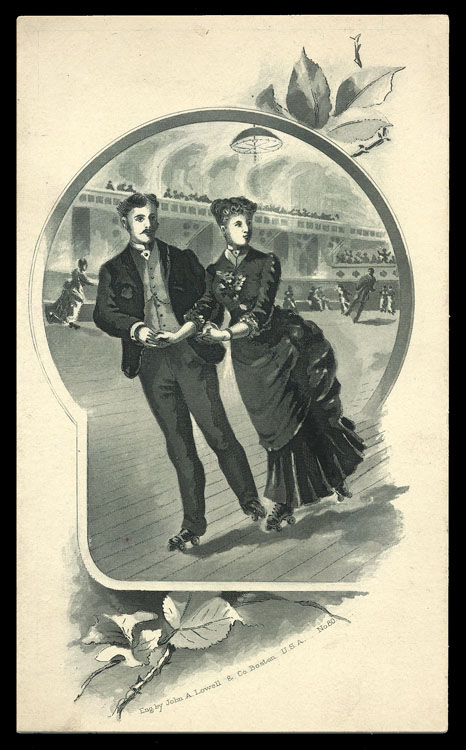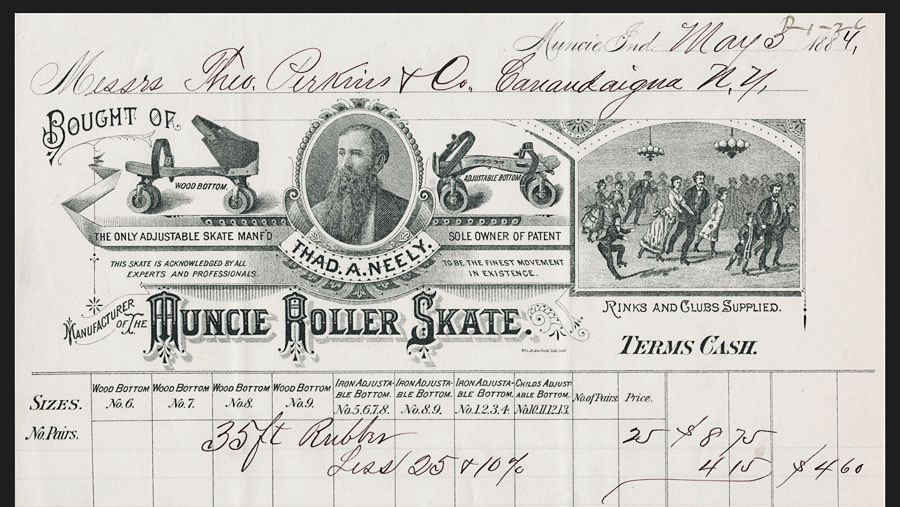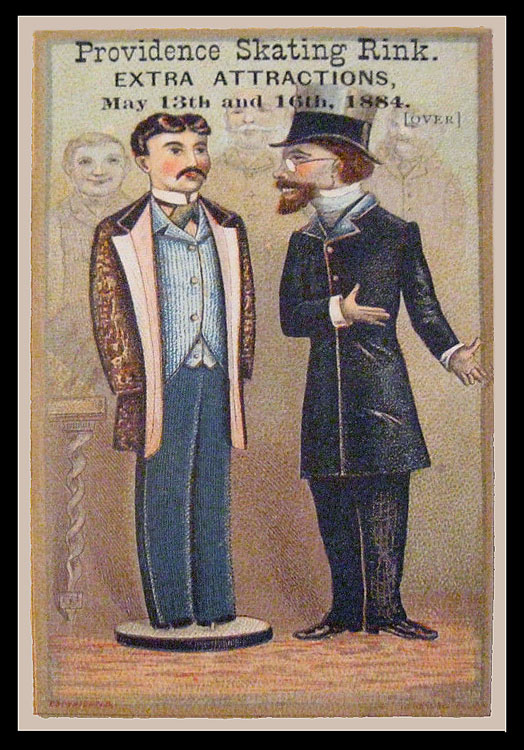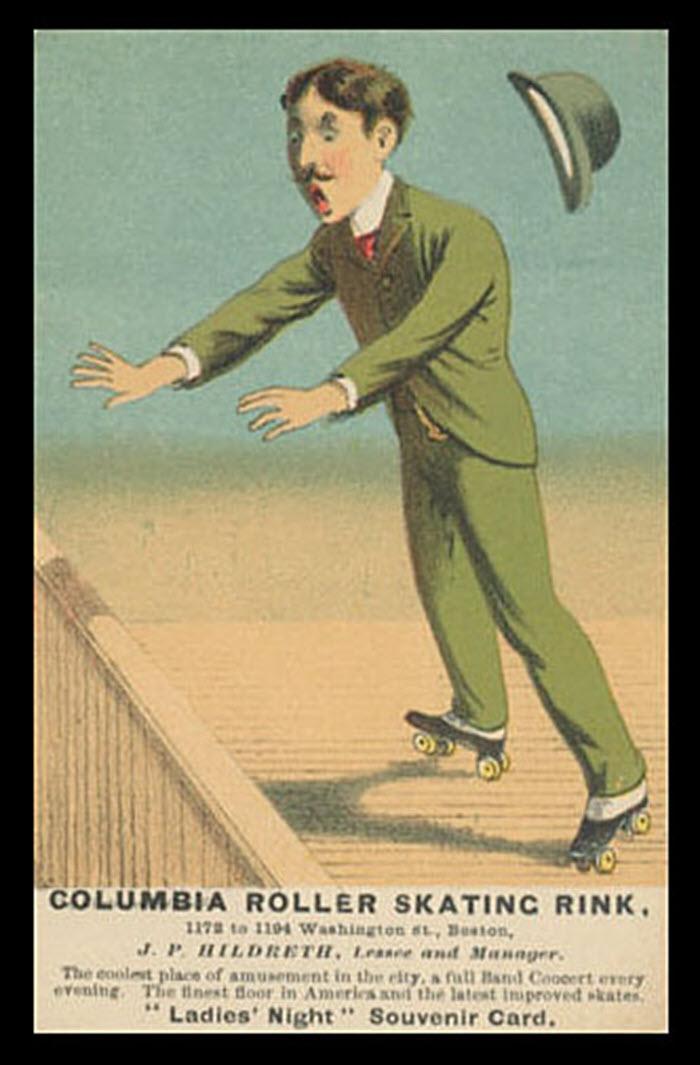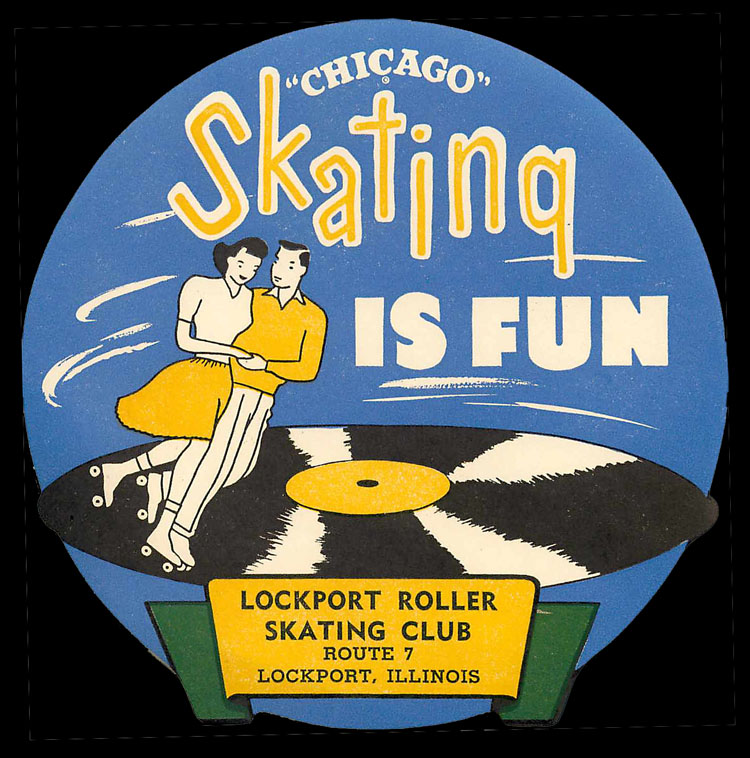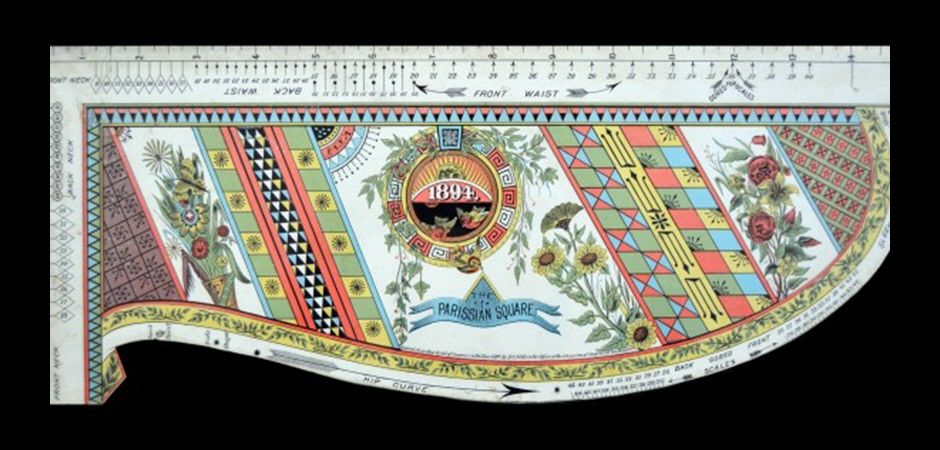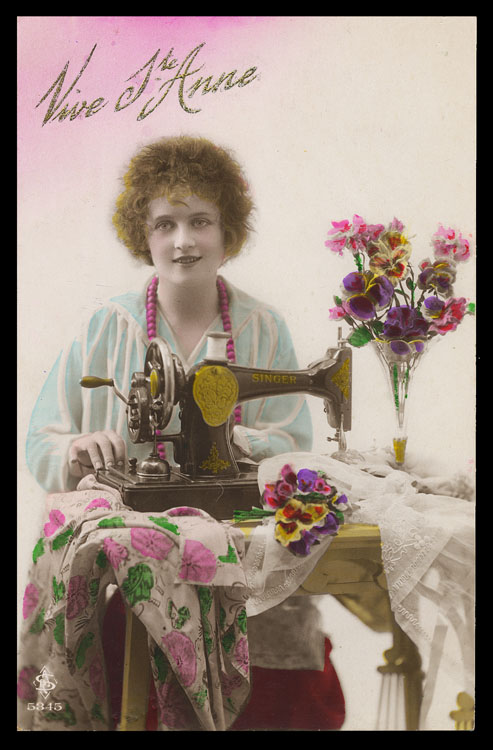Hunt’s Remedy
William E. Clarke of Providence, Rhode Island produced and marketed “Hunt’s Remedy”, a widely sold nostrum for kidney complaints, for decades. Research into Providence city directories provides insight into Clarke and his activities. Clarke was a grocer situated at College & Benefit Streets in 1844. His name appears in 1860 listed as a clerk at a business located at 43 Wickenden Street; I suspect the number “43” might be a typographical error and that Clarkemay have worked at the apothecary and dry goods store of Benjamin Bailey at 46 & 48 Wickenden. Clarke’s home address is given as 58 Sheldon Street, which is also the address of John Clarke, “Carpenter & Builder”.
I strongly suspect that John (whose directory appearances and advertisements date back to 1850) was William’s father.
William’s name does not appear again until 1864, at the end of the Civil War. Research in other sources indicate that he enrolled in the 11th Regiment of the Rhode Island Volunteers on September 15, 1862. On October 1, 1892 he mustered in as a 2nd Lieutenant in Company A of that unit. Clarke was promoted to 1st Lieutenant in March of 1863, mustered in to Company C. In April of 1863, he was made Adjutant Aide-de-Camp on the staff of Brigadier General John Potts Slough. He was discharged from the Army on July 13, 1863.
On November 4, 1863 Clarke married Emma P. Mason of Providence. In the 1864 directory he is listed as an apothecary at 233 South Main Street (“Corner of South Main and Transit Sts.”), and as boarding at 58 Williams Street. In 1866 he is listed as a clerk again, at 40 Weybosset Street (the address of Mason, Dawley & Baker, apothecaries).
Importantly to the story of his career, in 1866 the earliest advertisement for Hunt’s Remedy of Providence which I have so far uncovered (appearing on a broadsheet “The National Hotel Register”, December 5, 1866, Worcester, Massachusetts) lists “William E. Clarke, Proprietor, 28 Market Street, Providence.” The 1867 Providence directory lists him as the proprietor of an apothecary at 28 Market Street. Later, in an 1883 Hunt’s Remedy “ABC” advertising pamphlet, Clarke states that Hunt’s Remedy “had been on the market several years prior to 1867” and also that “In 1867 Hunt’s Remedy attracted my particular attention”.

The Hunt’s store at 28 Market Street with his traveling wagon posed out front, complete with dog sitting in the front, 1860s.
The man in the doorway is likely William E. Clarke, and the driver holding the reins may well be his traveling salesman W. B. Blanding. ( from a stereo view in Sheaff collection )
Various sources have reported over the years variations of a story saying that a Dr. David Hosack (1769-1835), practicing in New York City, concocted and sold a medicine said to cure kidney, liver and bladder problems, as well as dropsy (swelling of soft tissues from water retention). The medicine was reported to have been re-formulated from a medicine used by earlier Dutch settlers, and Hosack’s version was credited with saving the life of New York City grocer Frederick P. Hunt, who—after substantial recovery—began himself to manufacture and sell the nostrum, beginning in 1850. After Hunt’s death, his wife and a Dr. John C. Peters tinkered with the formula and continued to market it. The formula and the rights to manufacture it were bought by William E. Clarke on May 9, 1872. Thus, Clarke’s 1883 assertion that the medicine had been sold before 1867 must have been referring to sales by Mr. Hunt, and later Mrs. Hunt.
Alternately, one source (The Advertising Trade Card Quarterly, Summer 1998) states that the Hunt’s name came about because Clarke had been employed by Providence physician “Simeon Hunt . . . to compound his prescriptions for bottling and sale to the public around 1870, and . . . the company took on life of its own”. This narrative has yet to be confirmed. There was a Providence Simeon Hunt who marketed a different nostrum called “Hunt’s Gold Leaf Liniment” (advertised, for example, in the August 24, 1868 issue of the Providence Daily Journal).
“On May 9, 1872, ‘The Great Kidney Medicine’ came into the possession of William E. Clarke of Providence, Rhode Island. A few months later the name “HUNT’S REMEDY” inscribed on a broad, ribbon-like label with notched ends was entered according to Act of Congress in the office of the Librarian of Congress at Washington, as a trade mark.” (Henry Holcombe, Patent Medicine Tax Stamps, Quarterman, 1979 p.94)
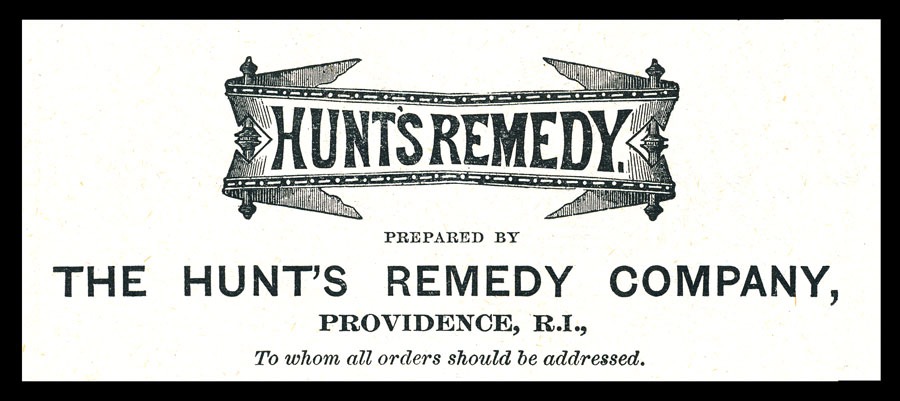
According to one source, Clarke had opened a second apothecary shop located at the corner of Broad and Mathewson Streets, along with maintaining his original shop at 28 Market Square; that second store was closed in 1872.
On June 3, 1873 a rectangular small space ad for Hunt’s Remedy began to appear in The Opera Glass publication. Also in 1873, he was granted a patent for a bottle stopper. In 1873-74, “Mr. Clarke introduced “Hunt’s Health Pills and Liver Cure’, familiarly known as ‘Little Gems’.” (Holcombe, p.95) These were put up in tin boxes selling for 25¢. In 1877 Clarke introduced another medicine, “Hunt’s Infallible Eye-Wash”. (Holcombe p.95). In this same period, be briefly marketed mineral water in now-scarce torpedo shaped bottle.
In 1875, Clarke was admitted to the Rhode Island Pharmaceutical Association.
Somewhere in the early 1870s, Providence changed the house numberings on Williams Street, and by 1874 Clarke’s home address had become 68 Williams Street.
Over time, advertisements for Hunt’s Remedy, “The Great Kidney Medicine”, appeared in numerous publications around the country.
“Hunt’s Infallible Eye-Wash, the Best in the World for all troubles of the Eyes—Soothing, Cooling, Healing, Always Cures, Price 50¢” was introduced in 1877.
Clarke decided to have made a custom, “private die” 6¢ medicine revenue stamp to pay his required taxes on proprietary medicines. In 1878, “(Clarke) directed the National Bank Note Company of New York to engrave a die. A proof was approved by the Commissioner of Internal Revenue . . . on January 20, 1879. / / The entire issue on watermarked paper amounted to 115,249 stamps, about 550 sheets.” (Holcombe, p.95-96) The stamps began to be delivered to Clarke in 1879, with the final shipment made on November 24, 1880. (An Historical Reference List of the Revenue Stamps of the United States [the “Boston Book”], Toppan, Deats and Holland, 1899, p.235)
Hunt’s Remedy was sold in two sizes. The smaller embossed (“Trial Size”) bottle, selling for 75¢, required a 3¢ revenue stamp; the larger, selling for $1.25, required a 6¢ stamp. (Holcombe) Both of the bottles for those bottles were aqua in color. A much smaller “One Dime Size” sample bottle in amber glass is also known, but quite rare (two known to the author); these bottles are rectangular.
A 3¢ Hunt’s Remedy stamp in the same ribbon-logo design as the issued 6¢ stamp was created, but that stamp design was never approved or issued. A die proof is known.
“Early in 1880 a . . . die was ordered from the American Bank Note Company of New York, which had assumed the National (Bank Note Company) contracts for the printing of revenue stamps.” (Dr. Daniel Hoffman, Linn’s Stamp News, June 5, 1978, p.96) “This 3¢ blue stamp had as a central design “a man wrestling with death [a skeleton], who he is about to strike with a bottle [of Hunt’s Remedy].” (ibid) “A proof from this new 3¢ die was approved in February 1880, and a single printing of 9,000 stamps was made in April of 1880.” (ibid)
[ Note: The proprietary stamp tax was repealed as of July 1, 1883, and so these revenue stamps were no longer required on patent medicine products. ]
By 1880, Clarke’s business had been moved to 319 South Main Street.
Hunt’s Remedy issued a number of striking custom trade cards, as well as the occasional stock card imprinted with Hunt’s information. The only dated card is the one issued in 1883, featuring a comely girl in a blue sailor suit. Also in 1883, Hunt published a 56 pages plus cover booklet, “ABC of Society”. Among other things, it includes and interview with “Colonel Clarke” entitled A True Story, attributed to the Providence Journal. Hunt’s Remedy (labeled bottle and outer box pictured and described) is named a product of “Hunt’s Remedy Company, Proprietor”. Several other Clarke products are also promoted: “Hunt’s Infallible Eye-Wash”, “Clarke’s Florentine Dentifrice” (pictured), “Clarke’s Anti-Bilious Pills” (Clarke’s signature shown) and “Clarke’s Tooth-Ache Drops”. Clarke is reported to have been in the prescription business for 25 year (i.e. beginning about 1858). Regarding sales of Hunt’s Remedy in the Providence area, Clarke says “Mr. W. B. Blanding has sold in two years 33,120 bottles.” He states that the remedy had its greatest sales in New England, and goes on to say “Some medicines build up a reputation in the Territories and Western States, where anything will sell; but Hunt’s Remedy was its widest field in New England . . . The Remedy is known, however, throughout the United States and Canada, and in foreign countries.” “For the purpose of bringing Hunt’s Remedy to the attention of the many thousands of sufferers from kidney and liver diseases, a stock company has been formed with sufficient capital to introduce the remedy into every part of the country and throughout the domain of the world.” [Note: Author has never seen a stock certificate for Hunt’s Remedy.]
Hunt’s Remedy contained a high proportion of dogbane (Apocynum cannabium), according to The Medical Record, July 19, 1884.(The Quack Doctor, Caroline Rance, History Press, Ltd. 2013) Dogbane is similar to digitalis in its effects on the cardiac system. Native Americans used the plant to make twine, fishing nets, cloth and medicines. It is said to have sedative and hypnotic effects, and has been to treat fever, diarrhea, intestinal worms, dysentery, rheumatism and syphilis.
Regarding Clarke’s military rank, he remained involved with the Army after the war. “Company B, of the First Rhode Island Volunteers was recruited among the members of this company, and took part in the battle of Bull Run, July 21 and 22, 1861. The regiment had been known for a long time as the Providence Artillery. In 1869, it changed its name to the Burnside Zouaves; but the next year the name was again changed to the United Train of Artillery. The regiment has been commanded since October, 1874, by Colonel William E. Clarke. The regiment is in a very flourishing condition, and has upon its muster-rolls over two hundred active members.” (The History of Providence, 1878)
Another, previously unknown, embossed bottle for a Clarke product was discovered in 2002. Cylindrical, aqua, 5” tall, with an applied lip, it reads INFANT SOOTHER / WILLIAM E. CLARKE / PROPRIETOR / PROVIDENCE RI.
In the 1886 Providence directory, the Hunt’s Remedy Company is listed at “112 South Main Street, corner James”; but Clarke himself is listed not with Hunt’s, but as general agent for the Eagle Machine Company, a manufacturer of folding steel gates. In 1887 Clarke left Eagle Machine and joined the Quaker Medicine Company. From 1886 to 1888 Clarke served as the representative in Common Council from the Third Ward; from 1888 to 1890 he served in the same capacity representing the First Ward. In 1889 he resigned from the Rhode Island Pharmaceutical Association. He served as Alderman from the First Ward from January 1, to May 26, 1890.
In 1890, The Hunt’s Remedy Company is listed at 319 South Main Street, with Edward R. Dawley, an apothecary who had been Clarke’s employer in 1866. Dawley apparently had worked for Clarke at Hunt’s Remedy since 1882, until becoming Secretary of the company in 1884, and taking over as proprietor in 1886.
In 1890, Clarke is still listed as working at the Quaker Medicine Company, at 6 South Water Street.The Hunt’s Remedy company under Dawley remained in listed in subsequent directories through 1899. Dawley moved the firm to a different location in 1894. The firm continued to be listed in Providence without Dawley’s name through 1902, when it’s last advertisement appeared. In 1896 Dawley also became an officer in the Heather Blossom Whiskey division of the B.H.R. (Beverage Hill Road) Distilling Company of Pawtucket (the address for the Heather Blossom division was the same as for Hunt’s Remedy), quitting that in 1897. Dawley left the Hunt’s Remedy business in 1903, and became a city collector until his death in 1906.
One source states that in 1892 the Hunt’s Remedy Company was acquired by Charles N. Crittenden Company of New York, and sold by them in 1904. The exact relationship between Dawley and Crittenden is unclear.
The Pure Food and Drug Act, which reigned in unregulated patent and proprietary medicines sold to the public, took effect on June 6, 1906.
Clarke was elected Providence City Clerk on May 26, 1890 (succeeding Henry V. A. Joslin); he took office on June 2, 1890 (Providence City Manual, 1910, p.186, p.209), and he served in that capacity until his death on November 7, 1912. He also became Providence Record Commissioner on March 8, 1906 (Providence City Manual, 1910, p.209).

There was also another company which sold something called HUNT REMEDY (not “Hunt’s”) toward the end of the patent medicine era. Sold in a rectangular aqua bottle similar to the Hunt’s Remedy bottle but larger, it’s label identifies the maker as “Hunt Remedy Company, Ltd. / Trade Mark / Manufactured by Henry Thayer & Company / Cambridge, Boston, Mass.” That Hunt Remedy Company, Ltd. also sold Hunt’s Remedy (with the ‘s), ca. 1907, in a package giving its address as “originally from The Hunt Remedy Company, Ltd, Providence”.


Advertising corkscrew (known as a “cast cork ring”), embossed “Hunt’s Remedy” on the top, which came with each package. These were manufactured by the firm of C.T. Williamson (successor to Clough & Williamson), Trenton, NJ. An 1881 promotional piece by that company (in Sheaff collection) lists W.E. Clarke as a customer.



The two sizes of aqua glass Hunt’s Remedy bottles looked basically like this, though there are numerous variations resulting from various molds used for various lots of bottles ordered. (Drawing by Joseph K. Baldwin, from his book Patent and Proprietary Medicine Bottles of the Nineteenth Century, 1973 p. 260)

Small (4 1/4″ tall) “ONE DIME SAMPLE” bottle, the only Hunt’s bottle in amber. Very rare (two known to date)

The most common Hunt’s Remedy trade card “Copyrighted 1883”
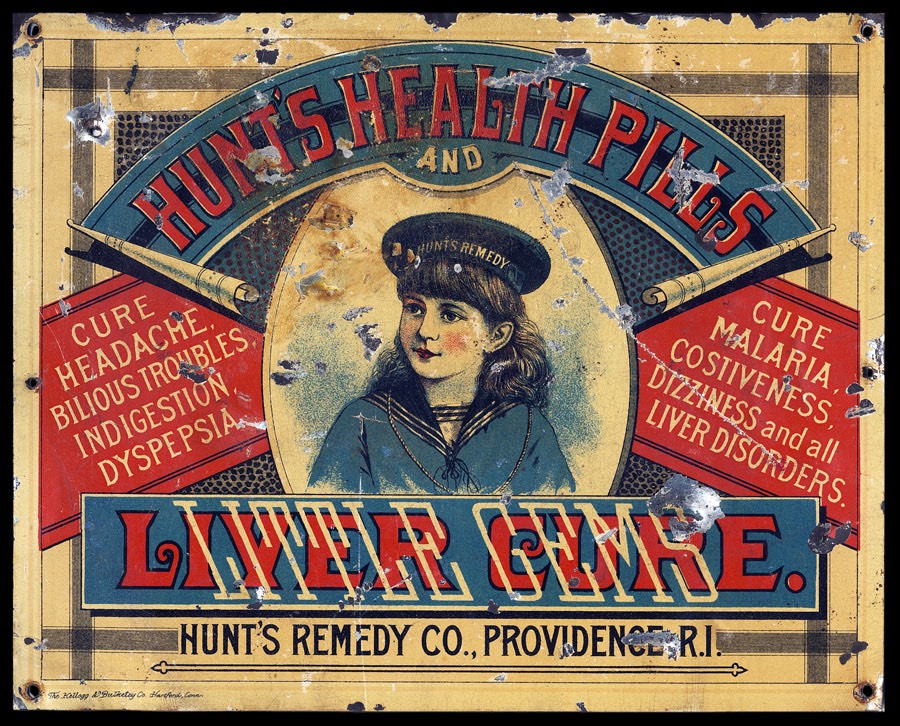
Metal sign, extremely rare

The most graphic Hunt’s Remedy trade card

Extremely rare, large (5 1/2″) store card in a design very similar to the smaller trade card. Two known.

The issued 3¢ private die proprietary stamp, RS 56

Trial color proof of the 3¢ ( one of several in Sheaff collection )

Plate proof block of 8 of the 3¢ in the issued color, with American Bank Note imprint at bottom

Steel engraved bookplate of well-known Revenue stamps collector and researcher George F. Turner. Each stamp was newly engraved for the bookplate at a size smaller than the actual stamps; The Hunt’s Remedy medicine revenue stamp, printed in red ink, is enlarged at the right above.

The issued 6¢ private die proprietary stamp, RS 57

A mis-perforated example of RS 57

Trial color proof of the 6¢ ( one of several in Sheaff collection )

Another trade card with the beating-off-death-with-Hunt’s theme

Trade card, cured man leaping out of bed

Trade card, doctors amazed by the patient’s recovery after using Hunt’s Remedy

Trade card

Trade card

Trade card

Trade card

Back cover of 1883 “ABC” promotional booklet

Front cover of 1883 “ABC” promotional booklet

Front cover of 1887 promotional booklet

Back cover of 1887 promotional booklet

A stock trade card imprinted for Hunt’s

A stock trade card. Clarke & Durfee being researched.

Advertising cover, 1883

Envelope used to mail one of the Hunt’s promotional booklets

Envelope, bearing the Rhode Island state seal, which contained a 2-page broadside directed at women,promoting the use of Clarke’s medicines for female monthly needs.

A Hunt’s Remedy billboard sign on the Providence waterfront, 1860s The large brick building in the background belonged to an iron works, and is today a building owned by Brown University. The man posing outside the front railing of the boat could be the boat’s captain or owner . . . or could possibly be William Clarke, based on the fact that this stereo view came with and is a companion to the Clarke storefront stereo view shown above. ( from a stereo view in Sheaff collection )
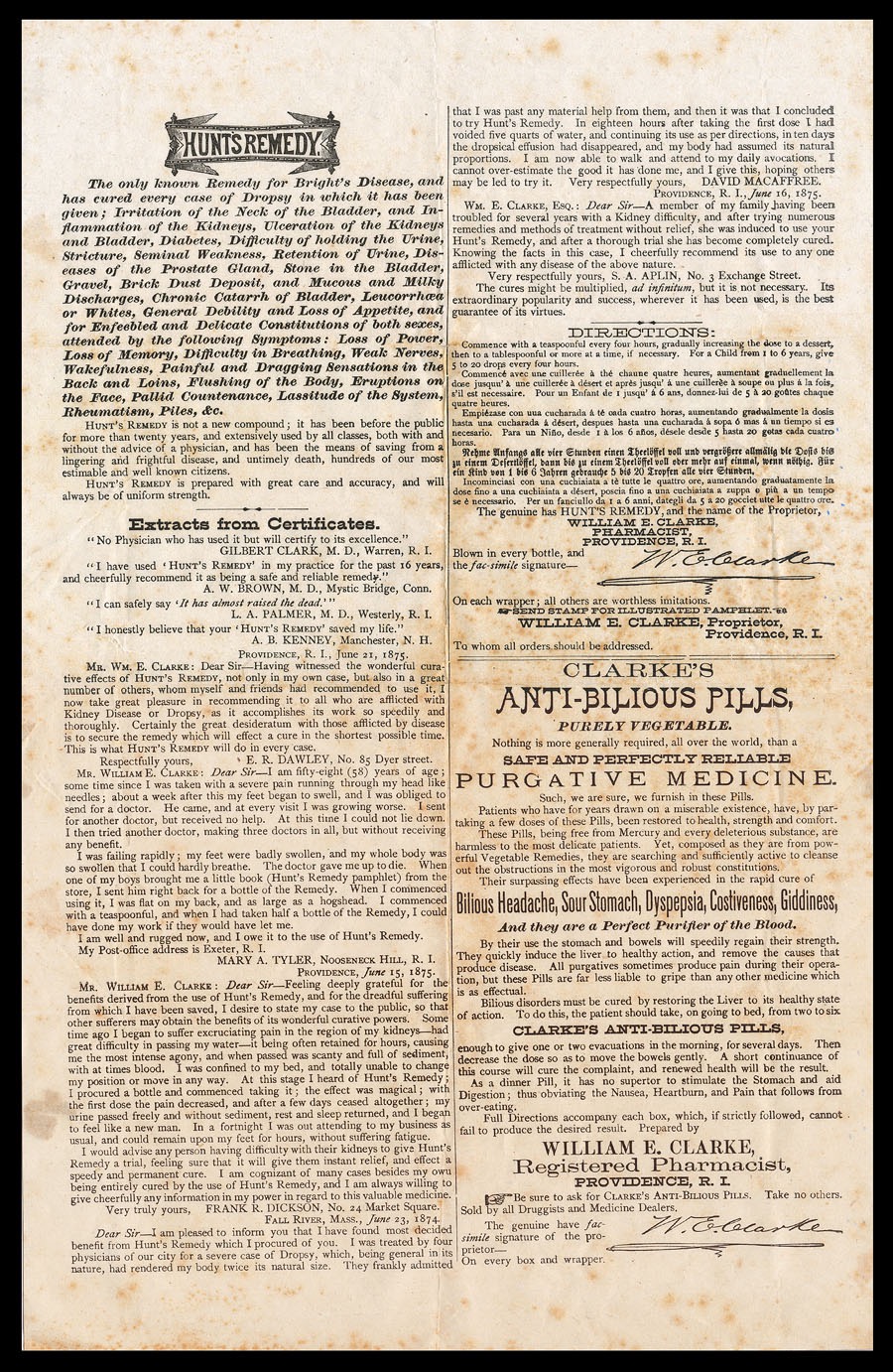
1875 broadside, @ 10″ x 15″

1883 advertisement

1887 advertisement

1884 advertisement

1882 advertisement
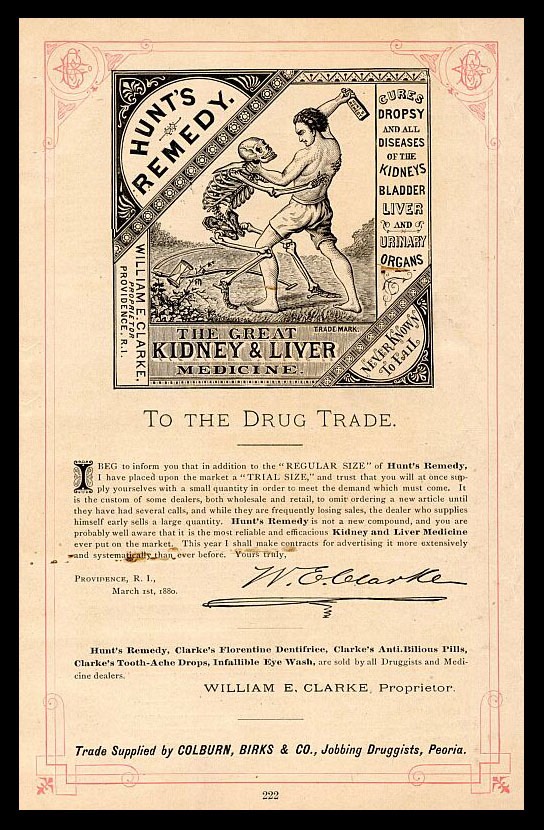
1880 advertisement in a pharmaceutical journal

1883 advertisement

1884 advertisement
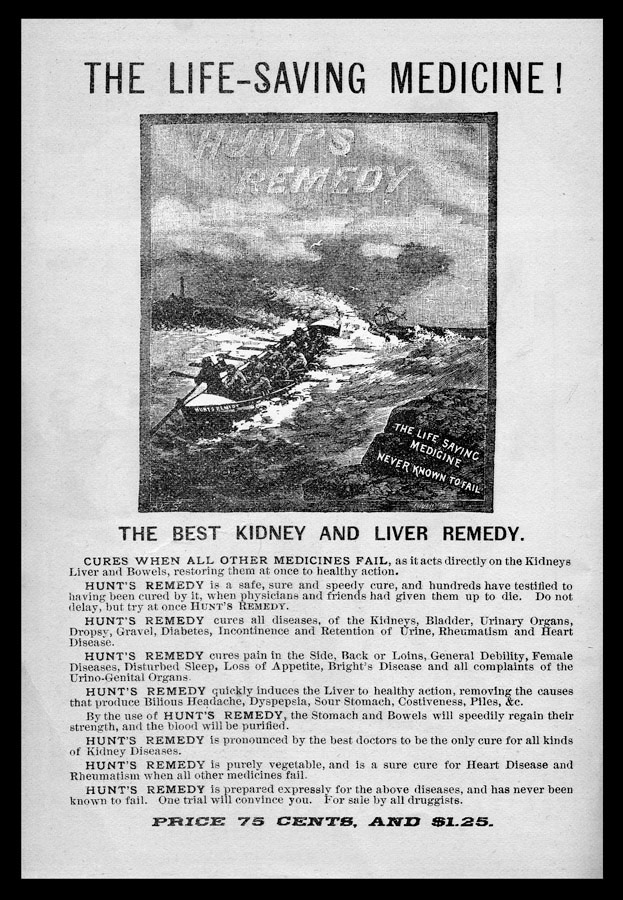
1883 advertisement

1896 advertisement

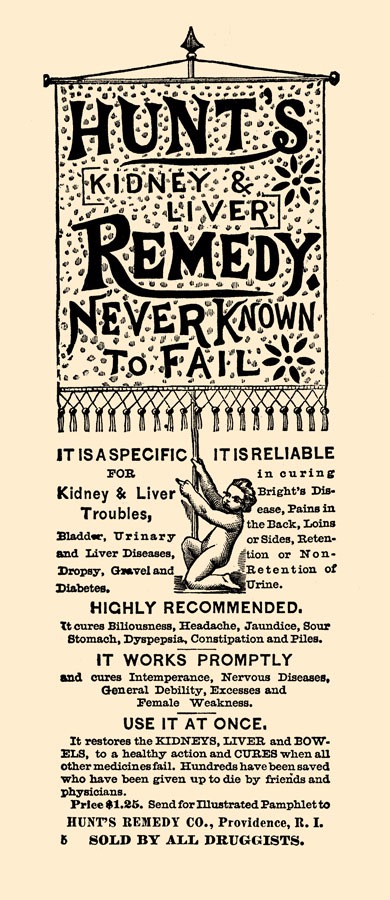
1884 advertisement

1866 ( ! ) advertisement

This advertisement is reproduced in the book One For A Man, Two For A Horse (Gerald Carson, 1961), original source unknown. Comparing with the photograph above, the wagon detail seem accurate.

Small card

Label
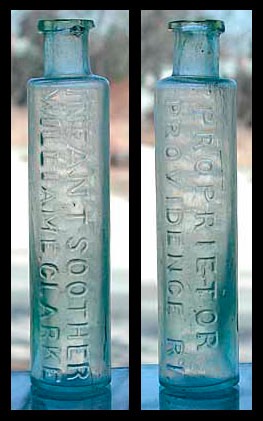
INFANT SOOTHER / WILLIAM E. CLARKE / PROPRIETOR / PROVIDENCE, RI

A later product (“Hunt”, not “Hunt’s”), Henry Thayer and Company

Another imitator, Radams Microbe Killer, adopted the medicine-beating-off-death motif, even embossing it into the glass of its bottles. Contemporary analysis indicates that this nostrum contained sulphuric acid, muriatic acid, red wine and by volume mostly water. (19th Century Medicine, Bill & Betty Wilson)
(logo image from Quack Quack Quack by William Helfand, 2002)

Military marching band affair at Clarke’s 59 Williams Street house, 1886. Clarke is thought to be the gentleman in top hat at the front gate, or one of the men in uniform near the front.

59 Williams Street in 1959 (Providence Journal photograph)

59 Williams Street today

Front cover of the periodical Puck, 1882, a cartoon about American quack medicine hucksters. Some patent medicines may have been helpful to buyers; most were clearly enterprises intended to separate rubes from their money; many contained alcohol, opium, morphine . . . or all three.
Until The Pure Food & Drug Act of 1906, it was an unregulated industry.

My adaptation of the Hunt’s Remedy trade card for a U.S. postage stamp issued in 1998 as part of the Celebrate The Century series; one of the stamps commemorating events from 1900-1910, Scott #1080.
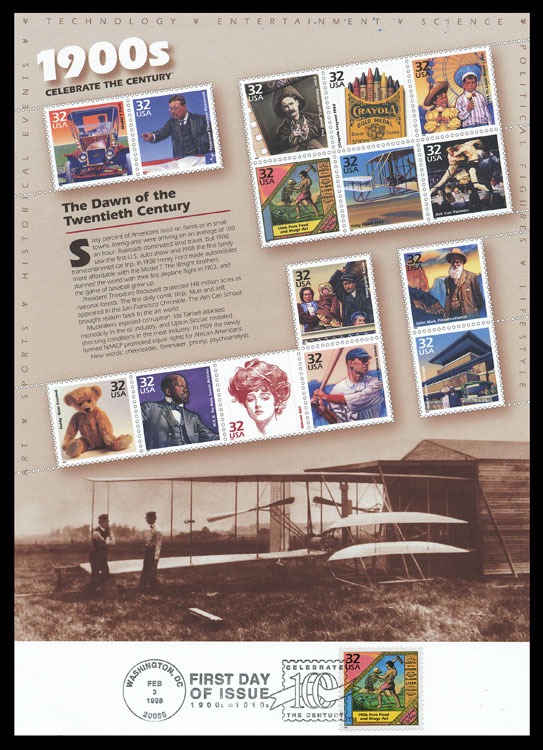
A First Day of Issue item showing the 1900-1910 sheetlet which includes the Hunt’s design.
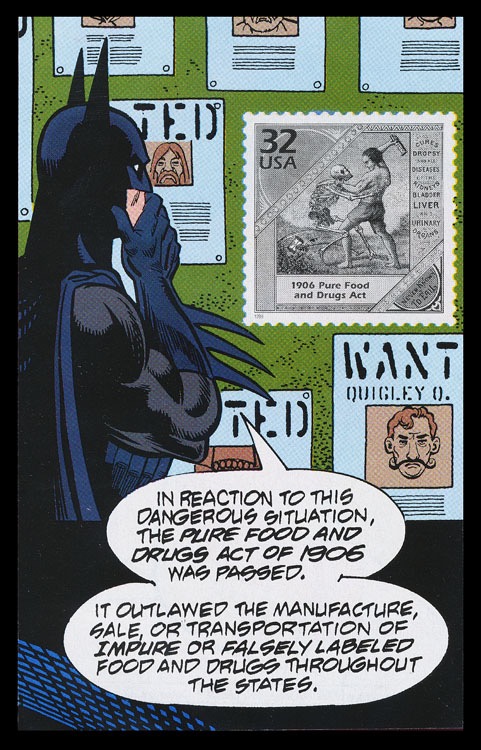
The U.S. Postal Service also issued a series of collateral comic books for each decade of the century; this is the space where a collector could mount one of the Hunt’s-based stamps.










